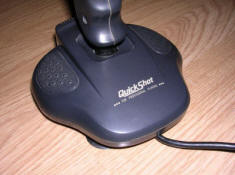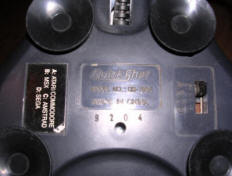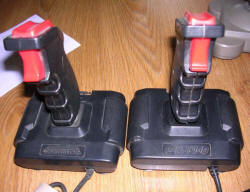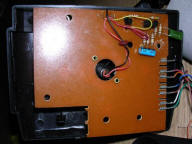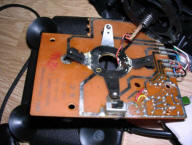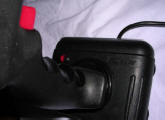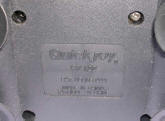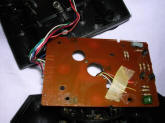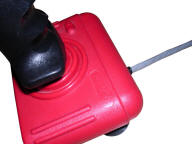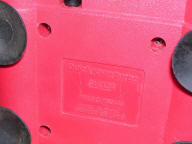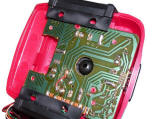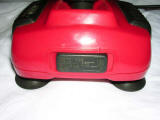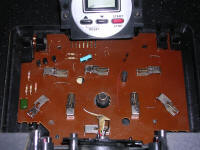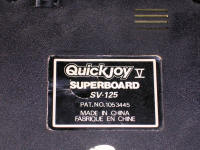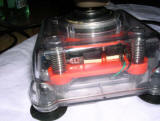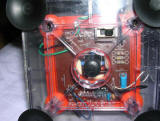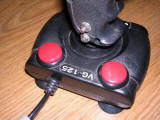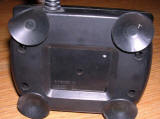Joysticks
The first attempts to drive the machine using coordinates entered with 2D electronic controllers were made during World War II in Von Braun's research of V2 rocket and Henschel Hs 293 remote controlled missile. Later, joysticks were common in NASA space program in 1960s and they spread to hobbyists in radio-controlled models. In 1970s and 80s paddles equipped with resistance trimmers became insufficient for controlling early video games, as they were able only to work in one dimension, so joysticks started to be used.Most (if not all) joysticks in microcomputers are digital ones, which means that they use on/off switches for every direction instead of trimmers. They are cheap and not reliable, as their contacts may wear out very quickly. There are many types of technology used in these contacts, but it's simpler to divide them to two: Joysticks with conductive contact switches similar to these used in remote controllers (or metal membrane switches like in calculators, grounded metal contacting PCB track or neutral metal contacting two tracks together) were cheaper, but less reliable than more expensive joysticks with microswitches.
The usual standard for these devices, called Atari standard, uses DB9 female plug at the joystick and is used not only in Atari computers, but in Commodore 64s, amigas and many other computers too. Exceptions are Amstrad, MSX and some Spectrum interfaces.
| Atari Joystick |
|
||
| Manufactured
by: ?Atari? |
|||
| Manufactured for: Atari
XL computers, some video games |
|||
| Technology:
Metal springs |
|||
| Addiditonal capabilities: - None except being the most known joystick, and the symbol of 8-bit gaming era. |
|||
| Well
known gaming joysticks, which became symbol of 1980s 8-bit gaming
era. Their mechanism gives uniform, durable yoke, but poor contacts
based on PCB tracks shorted by metal springs. My unit is probably not genuine Atari one. |
|||
|
|
|||
| QuickShot QS-129F |
|
||||
| Manufactured
by: QuickShot |
|
||||
| Manufactured for: Atari/Commodore,
CPC, MSX, Sega video games (selectable by switch) |
|||||
| Technology:
Rubber membrane |
|||||
| Additional capabilities:
- Unusual shape, more ergonomic in some games - Autofire. - Compatible with many standards.
|
|||||
| The
unusual shape of its joystick is useful in games where fast
switching of directions is needed - it can be used only with
thumbs. Unfortunately using cheap rubber membrane mechanism
made this joystick less reliable. The switching is: |
|||||
| QuickShot QS-130F |
|
||
|
Manufactured by: QuickShot |
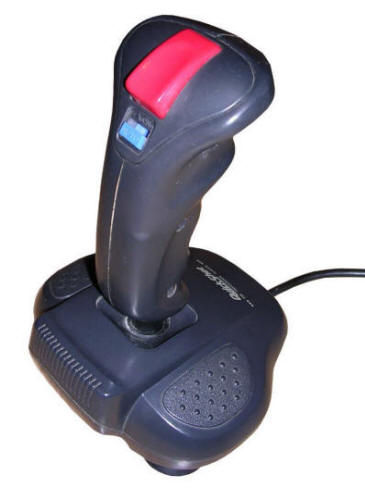 |
||
| Manufactured for:
Atari/Commodore, CPC, MSX, Sega video games (selectable
by switch) |
|||
|
Technology: Rubber membrane |
|||
| Additional capabilities:
- Autofire - Switch to select compatible computers.
|
|||
|
Autofire switch is located on the stick itself. This
joystick was used with 8-bit microcomputers such as
Atari and was sold in early 1990s. The switching
is: My unit's autofire requires to press fire button to
activate, maybe it's this way or maybe it's damaged. |
|||
| QuickShot QS-131 |
|
||
| Manufactured by: QuickShot |
|
||
| Manufactured for: Atari/Commodore/Amiga |
|||
| Technology:
Metal contacts |
|||
| Additional capabilities: - None
|
|||
| I got this unit
with Amiga and it's working quite nicely. It's built with metal
springs touching PCB tracks when joystick is used. Here
springs are part of circuit, so only one track needs to be shorted
for a direction. More reliable than 2-track joysticks. |
|||
| Sinclair Joystick |
|
||
| Manufactured by: Sinclair |
|
||
| Manufactured for: Sinclair
ZX Spectrum +2, +3 |
|||
| Technology:
Membrane? |
|||
| Additional capabilities: - Nothing excitig here... |
|||
|
Special joysticks used with ZX spectrum +2 computer. I have
2 units, one with red and one with yellow buttons. |
|||
| Spectravideo SV-102 |
|
||
| Manufactured
by: Spectraviedo |
|
||
| Manufactured for: Atari/Commodore |
|||
| Technology:
Metal contacts |
|||
| Additional capabilities: - Autofire. |
|||
| Spectravideo
made many good joysticks which were produced and marketed as
QuickJoy too. This one is the simplest one, only with autofire
function. Below you can see two of these joysticks, marked both Spectravideo and QuickShot, when they atarted QS series. |
|||
| Spectravideo SVI-102 Plus (QuickShot II) |
|
||
| Manufactured
by: Spectravideo |
|
||
| Manufactured for: Atari/Commodore |
|||
| Technology:
Microswitch |
|||
| Additional capabilities: - Autifore - More reliable than SV-102
|
|||
|
In 1984 Spectravideo renamed their products from SV to
SVI, but nothing more happened. The only difference between SV-102 and SVI-102 plus is switching technology - Plus model is more reliable as it uses microswitches instead of metal contacts. This model has been marketed as QuickShot II Plus. |
|||
| Spectravideo SV-121 |
|
||
| Manufactured by: Spectravideo |
|
||
| Manufactured for: Atari/Commodore | |||
| Technology: Metal contacts. | |||
| Additional capabilities: - Nothing interesting.
|
|||
| The simplest SVI model, sold as QuickJoy QJ I Turbo. No autofire, only Atari standard supported. | |||
| Spectravideo SV-122 |
|
||
| Manufactured by: Spectravideo |
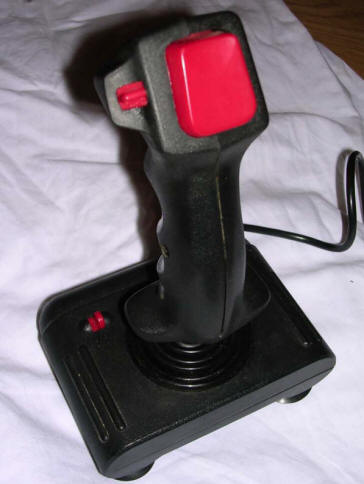 |
||
| Manufactured for: Atari/Commodore, Amstrad CPC | |||
| Technology: Metal contacts. | |||
| Additional capabilities: - Autofire - Amstrad CPC compatibility (switch) |
|||
| A bit better model, roughly comparable with later SV-124, used metal springs as contacts. | |||
|
|
|||
| Spectravideo SV-123 |
|
||
| Manufactured by: Spectravideo |
|
||
| Manufactured for: Atari/Commodore/Amstrad
CPC |
|||
| Technology:
Microswitches |
|||
| Additional capabilities: - Autofire - Amstrad CPC support by switch |
|||
|
Very popular joysticks known as QuickJoy Supercharger, QJ III
Supercharger / SuperJoy III or variations of these. Thanks to
microswitches it's reliable, and it has CPC support activated
with switch.
|
|||
| Spectravideo SV-124 |
|
||
| Manufactured by: Spectravideo |
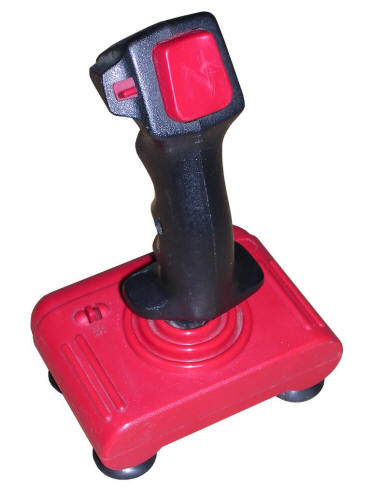 |
||
| Manufactured for:
Atari/Commodore, Amstrad CPC |
|||
|
Technology: Microswitches |
|||
| Additional capabilities:
- Simpe autofire - Amstrad CPC support
|
|||
| Sold as QuickJoy II Turbo. Sometimes sold with NES-clone game consoles. | |||
| Spectravideo SV-126 |
|
||
| Manufactured by: Spectravideo |
|
||
| Manufactured for: Atari/Commodore,
Amstrad CPC |
|||
| Technology:
Microswitches |
|||
| Additional capabilities: - Two level (frequency) autofire. - Amstrad CPC support
|
|||
| Sold as QuickJoy JetFighter, it was known as reliable, but quite loud joystick. Yes, loud as microswitches made clicking sound while switching on and off. Another feature not commonly seen is two level autofire. | |||
| Spectravideo SV-111 / QS-111 |
|
||
| Manufactured by: Spectravideo |
|
||
| Manufactured for: Atari/Commodore,
Amstrad CPC |
|||
| Technology:
Microswitches |
|||
| Capabilities: - Autofire - Amstrad CPC support.
|
|||
| Marketed as QuickShot II Turbo, or QS-111 (licensed versions), was quite good as it used microswitches. However, some units are equipped with metal contacts. | |||
| QuickJoy Superboard V SV-125 |
|
||
| Manufactured by: Spectravideo |
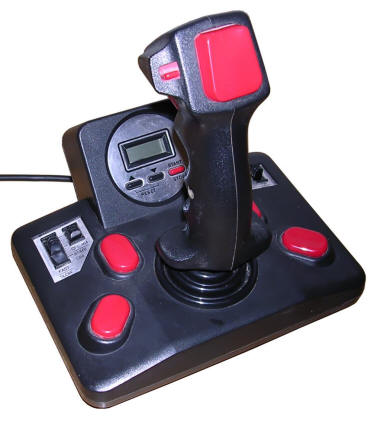 |
||
| Manufactured for: Atari/Commodore,
Amstrad CPC |
|||
| Technology:
Microswitches |
|||
| Capabilities: - Autofire with 3 frequency levels - Amstrad CPC support. - 3 pairs of Fire buttons, switchable: Stick, base left, base right. - Battery-powered stopwatch with alarm (AA type cell required) |
|||
|
It was known as very "professional" joystick, at least in Poland.
And it was very expensive. But technology was the same, microswitches,
the only new things were 3-level autofire, additional Fire buttons
and stopwatch. Stopwatch required 1 AA 1.5V cell. It can count down in minutes and, when time goes out, it beeps until button is pressed. |
|||
| QuickJoy / Spectravideo SV-127 |
|
||
| Manufactured by: Spectravideo |
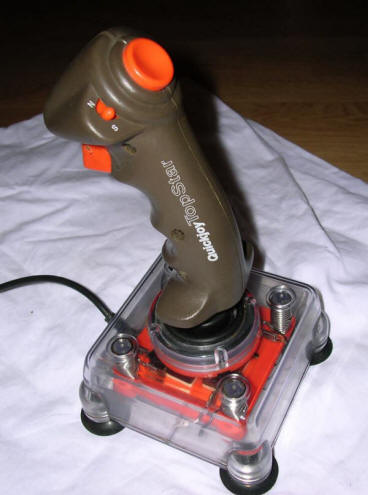 |
||
| Manufactured for: Atari/Commodore,
Amstrad CPC |
|||
| Technology:
Full Microswitches |
|||
| Capabilities: - Autofire with 2 frequency levels (started with holding sec. fire down), - Amstrad CPC support, - 2 Fire buttons. |
|||
|
One of the most rugged things in terms of contacts - this is
based on microswitches, a real microswitches, like ones in
old machine programmers. It has a transparent case and it is
possible to see the switches. Although it is solid, this
comes with price - it's loud. It has springs for vibrations
compensation, a stable base and rubber feet, but it is more
loud than typical switch-based joysticks. To start
autofire, hold secondary fire (large thumb button) for some
time. |
|||
| VG-125 |
|
||
| Manufactured by: ?? |
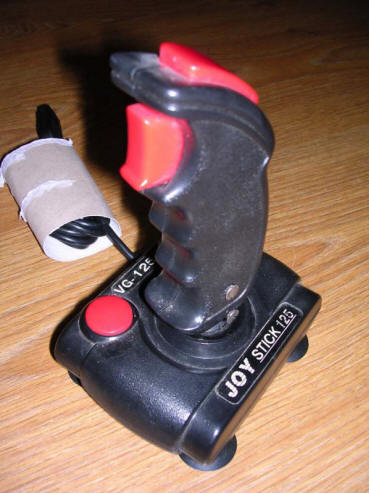 |
||
| Manufactured for:
Atari/Commodore |
|||
| Technology:
Metal contacts |
|||
| Capabilities: - 3 Fire buttons (in parallel) |
|||
|
Cheap, non-branded joystick made in China, they were
frequently added to Atari console clones or similar video
games. They were cheap
and accessible. 3 Fire buttons look nice, but they are
connected to single line. There are no markings related to
brand or manufacturer. This unit is quite surprising - I got it as "working but in poor condition", and it is like that - it's in rather bad state, with numerous fixes and repairs, but it works as intended and it is possible to play games without significant problems. |
|||
|
|
|||







